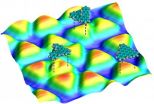Scientists at IRB Barcelona and BSC publish the world's largest video data bank of proteins
The new database, which includes 1,700 proteins in motion, allows a more efficient design of drugs; MoDEL holds 30 percent of human therapeutic targets and the objective is to cover 80 percent in 3 years
2010-11-12
(Press-News.org) After four years of conducting intensive calculations in the supercomputer MareNostrum at the Barcelona Supercomputing Center, scientists headed by Modesto Orozco at the Institute for Research in Biomedicine (IRB Barcelona) have presented the world's largest data base on protein motions. Called MoDEL, this new database holds more than 1,700 proteins and is partially accessible through Internet to researchers worldwide. MoDEL has been developed to study the basic biology of proteins and to accelerate and facilitate the design of new pharmaceutical agents.
"Nowadays we design drugs as if the proteins against which they are to act were static and this goes a long way to explain failures in the development of new drug therapies because this is not a true scenario. With MoDEL this problem is solved because it offers the user from 10,000 to 100,000 photos per protein, and these confer movement to these structures and allow a more accurate design", says Orozco, head of the "Molecular modelling and bioinformatics" group at IRB Barcelona, director of the Life Sciences Programme of the Barcelona Supercomputing Center and full professor at the University of Barcelona. According to this researcher, several pharmaceutical companies are already using the MoDEL strategy to develop the first drugs against cancer and inflammatory diseases, which could become available this year.
A project in expansion
The scientists that develop MoDEL work from an international catalogue of static protein structures (approximately 40,000) called the Protein Data Bank (PDB). "1,700 videos of proteins from the 40,000 that make up the PDB may appear to be a small proportion, but many of the structures in the PDB are very similar. Therefore, following internationally established similarity criteria, we are representing about 40% of the proteins with a known structure".
But for Modesto Orozco the most relevant point is that MoDEL is now covering more than 30% of human proteins structures that are of pharmacological interest, that is to say, those that are potential targets of a new drug. "We obtained this datum through a very strict test so we consider that we are in fact covering more. However, MoDEL will continue to grow and this can be achieved more quickly because the system is well established". According to the researchers, the main objective is to focus on relevant proteins in human diseases and in a period of between 2 and 3 years cover 80% of pharmaceutical targets.
In order to undertake the MoDEL project, Orozco and his group are supported by resources provided by IRB Barcelona, the Barcelona SuperComputing Center, the Marcelino Botín Foundation, the Fundación Genoma España, the National Bioinformatics Institute and several European projects.
INFORMATION:
Reference article
MoDEL (Molecular Dynamics Extended Library): A database of atomistic molecular dynamics trajectories".
Tim Meyer, Marco D'Abramo, Adam Hospital, Manuel Rueda, Carles Ferrer-Costa, Alberto Pérez, Oliver CarrilloJordi Camps, Carles Fenollosa, Dmitry Repchevsky, Josep Ll. Gelpi, and Modesto Orozco.
Structure (Nov. 10 print issue, 2010).
END
ELSE PRESS RELEASES FROM THIS DATE:
2010-11-12
Now that the 2010 election is over, here is something to consider for the 2012 race: If you want to fatten your company's profits, contribute to a political campaign.
A study by two College of Business Administration professors at the University of Tennessee, Knoxville, found that when firms engage in corporate political activities, such as lobbying and making campaign contributions, they enjoy about 20 percent higher performance. The study, by Russell Crook and David Woehr, along with Sean Lux of the University of South Florida, entitled "Mixing Business with Politics: ...
2010-11-12
Both the bully and the victim's individual characteristics, rather than the wider social environment, explain why bullying occurs, according to Swedish teenagers. The new study, by Dr. Robert Thornberg and Sven Knutsen from Linköping University in Sweden, also shows that 42 percent of teenagers blamed the victim for the bullying. The study is published online in Springer's journal, Child & Youth Care Forum.
In one of the rare studies investigating young people's views on why bullying takes place in school, Thornberg and Knutsen explored how teenagers explain bullying ...
2010-11-12
Electronic components are getting smaller and smaller, with microelectronic components gradually being replaced by nanoelectronic ones. On nanoscale dimensions, silicon, which is at the present stage the most commonly used material in semiconductor technology, reaches however a limit, preventing further miniaturization and technological progress. New electronic materials are therefore in great demand. Due to its outstanding electronic properties, graphene, a two-dimensional carbon network, is considered as a possible replacement. However, several obstacles must be overcome ...
2010-11-12
Fear arises in the almond-shaped brain structure known as the amygdala. It is the amygdala which processes the strange noise, shadowy figure or scary face and not only triggers palpitations or nausea but can also cause us to flee or freeze. That much has long been known about the function of this part of the brain. What remains largely unclear, however, is precisely how fear develops, and which of the countless neurons in the amygdaloid region are involved in this process. But finding answers to these questions is vital for those who wish to improve the quality of life ...
2010-11-12
Spanish and American researchers have conducted a mineralogical and chemical analysis to ascertain the origin of "terra rossa" soil in the Mediterranean. The results of the study reveal that mineral dust from the African regions of the Sahara and Sahel, which emit between 600 and 700 tonnes of dust a year, brought about the reddish soil in Mediterranean regions such as Mallorca and Sardinia between 12,000 and 25,000 years ago.
"The first hint of the relationship between African dust and certain soils in the region of the Mediterranean is their reddish or reddish-brown ...
2010-11-12
MAYWOOD, Ill. -- Alcohol does much more harm to the body than just damaging the liver. Drinking also can weaken the immune system, slow healing, impair bone formation, increase the risk of HIV transmission and hinder recovery from burns, trauma, bleeding and surgery.
Researchers released the latest findings on such negative effects of alcohol during a meeting Nov. 19 of the Alcohol and Immunology Research Interest Group, held at Loyola University Medical Center.
At Loyola, about 50 faculty members, technicians, post-doctoral fellows and students are conducting alcohol ...
2010-11-12
DURHAM, N.C. -- Leaks from carbon dioxide injected deep underground to help fight climate change could bubble up into drinking water aquifers near the surface, driving up levels of contaminants in the water tenfold or more in some places, according to a study by Duke University scientists.
Based on a year-long analysis of core samples from four drinking water aquifers, "We found the potential for contamination is real, but there are ways to avoid or reduce the risk," says Robert B. Jackson, Nicholas Professor of Global Environmental Change and professor of biology at ...
2010-11-12
HOUSTON -- (Nov. 11, 2010) -- Future computers may run a little sweeter, thanks to a refinement in the manufacture of graphene at Rice University.
Rice researchers have learned to make pristine sheets of graphene, the one-atom-thick form of carbon, from plain table sugar and other carbon-based substances. They do so in a one-step process at temperatures low enough to make graphene easy to manufacture.
The lab of Rice chemist James Tour reported in the online version of the journal Nature this week that large-area, high-quality graphene can be grown from a number of ...
2010-11-12
JUPITER, FL, November 9, 2010 – For Immediate Release – Scientists from the Florida campus of The Scripps Research Institute have identified for the first time a novel mechanism that regulates circadian rhythm, the master clock that controls the body's natural 24-hour physiological cycle. These new findings could provide a new target not only for jet lag, shift work, and sleep disturbances, but also for disorders that result from circadian rhythm disruption, including diabetes and obesity as well as some types of cancer.
The study is published in the November 12, 2010 ...
2010-11-12
WINSTON-SALEM, N.C. – Thursday, Nov. 11, 2010 – Arsenic, a toxic compound with a reputation as a good tool for committing homicide, has a significant positive effect on the survival of patients with acute promyelocytic leukemia (APL), when administered after standard initial treatment, according to a new, multi-center study led by a researcher at Wake Forest University Baptist Medical Center.
While arsenic trioxide (As2O3) is known by clinicians to be a highly effective treatment for patients with relapsed APL, its benefit earlier in treatment, after first remission, ...
LAST 30 PRESS RELEASES:
[Press-News.org] Scientists at IRB Barcelona and BSC publish the world's largest video data bank of proteins
The new database, which includes 1,700 proteins in motion, allows a more efficient design of drugs; MoDEL holds 30 percent of human therapeutic targets and the objective is to cover 80 percent in 3 years


